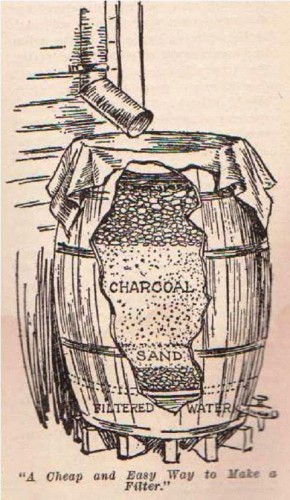100-year-old way to filter rainwater in a barrel
During our boiling, broiling, blistering drought last summer here in the Missouri Ozarks, water was a topic of conversation wherever we went. Creeks and ponds dried up (some never recovered) and the water table dropped, forcing some neighbors to have their well pumps lowered or to even to have a deeper well drilled.
We talked with many folks who shared memories of rain barrels, cisterns and drawing well water with a bucket as a child, usually on grandpa and grandma’s farm. Some said they’d never like to have to rely again on those old-time methods of getting water. But, at least they knew how it was done. It seems we have lost much practical knowledge in the last 50 or so years because we thought we no longer needed it.
Household Discoveries and Mrs. Curtis’ Cookbook
A 1909 book (link below) I found for $8 in a thrift store reveals how to make homemade water filters, another lost art. The instructions in “Household Discoveries and Mrs. Curtis’ Cookbook” are quite basic as everyone had a rain barrel back then and presumably knew how to clean the water. Now, more than 100 years later, I am thankful the authors had the foresight to preserve their knowledge for us, and pointed out that rainwater collected in barrels from a roof is a necessity in some locations, but also is best for laundry and “often more wholesome for drinking purposes than hard water.”
The “wholesome” observation applies to plants, too. I noticed during our 6-week dry spell that I was only able to keep my garden plants alive with the water hose. Then, after a 2-hour rain shower, the plants miraculously came to life – vibrant, green and THRIVING.
The old household book says the following instructions yield a cheap and easy way to make a filter just as good as a patent filter costing 10 times as much:
“Take a new vinegar barrel or an oak tub that has never been used, either a full cask or half size. Stand it on end raised on brick or stone from the ground. Insert a faucet near the bottom. Make a tight false bottom 3 or 4 inches from the bottom of the cask. Perforate this with small gimlet holes, and cover it with a piece of clean white canvas.
“Place on this false bottom a layer of clean pebbles 3 or 4 inches in thickness; next, a layer of clean washed sand and gravel; then coarsely granulated charcoal about the size of small peas. Charcoal made from hard marble is the best.
“After putting in a half bushel or so, pound it down firmly. Then put in more until the tub is filled within 1 foot of the top. Add a 3-inch layer of pebbles; and throw over the top a piece of canvas as a strainer. This canvas strainer can be removed and washed occasionally and the cask can be dumped out, pebbles cleansed and charcoal renewed every spring and fall, or once a year may be sufficient.
“This filter may be set in the cellar and used only for drinking water. Or it may be used in time of drought for filtering stagnant water, which would otherwise be unpalatable, for the use of stock. This also makes a good cider filter for the purpose of making vinegar. The cider should first be passed through cheese cloth to remove all coarser particles.
“Or a small cheap filter may be made from a flower pot. A fine sponge may be inserted in the hole and the pot filled about as directed for the above filter. It may be placed in the top of a jar, which will receive the filtered water.
“Or a valuable substitute for charcoal in the above filters is sponge iron obtained by burning finely divided iron ore with charcoal. This can be obtained in the locality of iron mines or smelting furnaces. This is much more powerful than charcoal, and is said to completely purify contaminated water.”
My copy of the 1,000-page book is yellowed and worn, I assume from many years of use in the house, barn and garden. Even though I could refer to an online copy, I prefer my tattered book and am hanging onto it. I have a feeling we’re going to need it.
To read the online version that covers everything from how to eradicate vermin and distill vinegar, visit http://archive.org/stream/cu31924089480218#page/n35/mode/2up.
If you have questions, please contact me at info@wellwaterboy.com. Our goal at Well WaterBoy Products is to help people live more self-sufficiently without relying on electricity. We are working steadily toward living off-grid and incorporating human-powered machines wherever possible. Visit us at www.wellwaterboy.com.
About the Author
| Mrs. WaterBoy |




